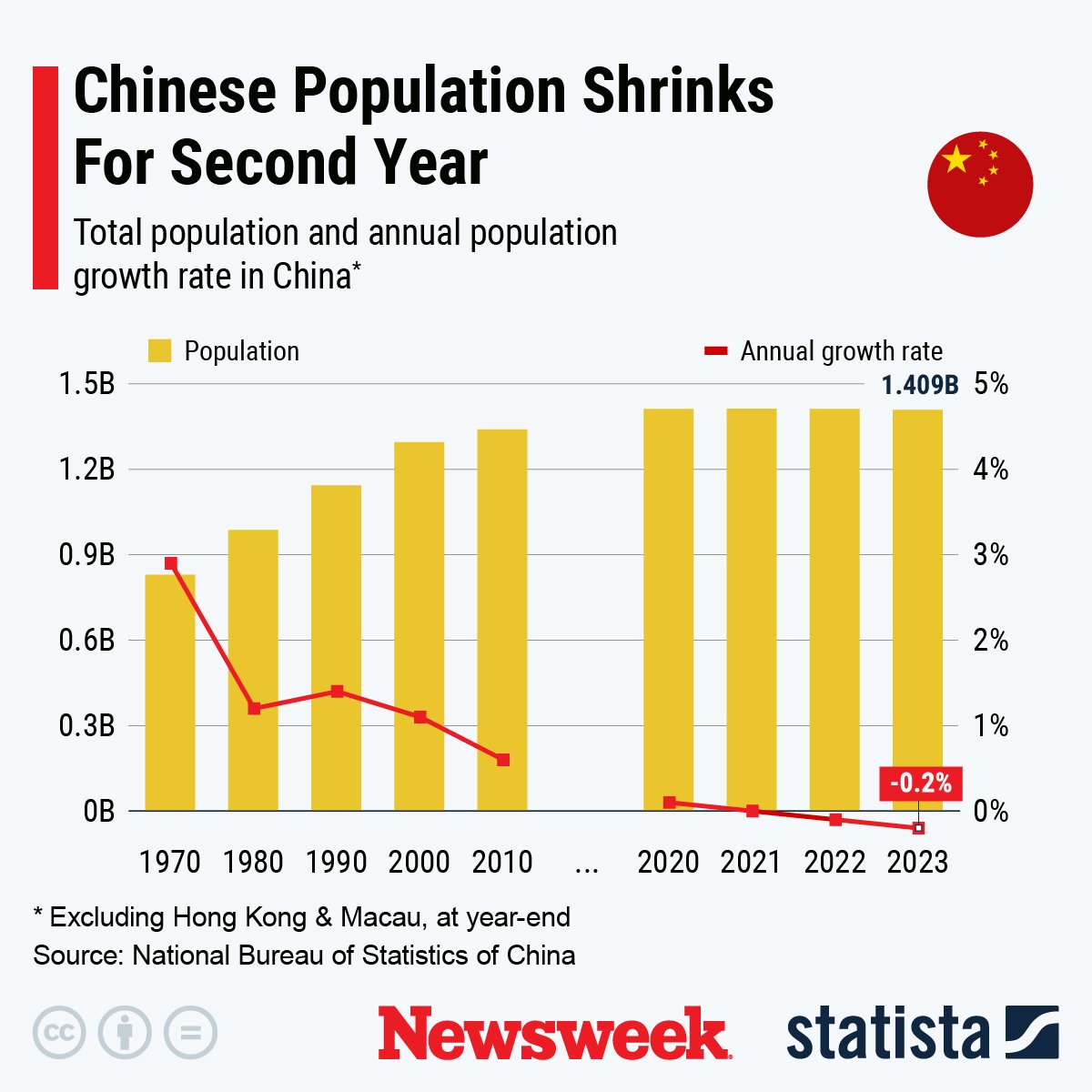China's population shrank for the second consecutive year in 2023, national statistics published on Wednesday show.
The new figures are a blow to the country's leader, Xi Jinping, as his government seeks to avert the worst of the approaching demographic time bomb.
The downward shift is concerning for the Chinese Communist Party government, which measures the one-party state's overall strength in comprehensive national power and comes amid an economic slowdown and greying workforce.
The National Bureau of Statistics of China published its latest annual report on population data compiled from 31 regions , including provinces, autonomous regions, and municipalities, on Wednesday.
The report did not include data on foreign residents, or the special administrative regions of Hong Kong and Macau. Nor did it include data on self-ruled Taiwan, which Beijing has vowed to bring into the fold despite never having governed there.
The population of China stood at 1.409 billion at the end of last year, down by 2.08 million from 2022—roughly equivalent to the inhabitance of Mississippi.
This was even more pronounced than the drop of 850,000 from 2021 to 2022, the first such decline in six decades.
Nationwide, there were 9.02 million births and 11.1 million deaths reported. It was the second consecutive year China posted under 10 million births.
The East Asian country's fertility rate also fell this year, with 6.39 births per 1,000 people.
The natural growth rate, defined as the difference between a country's birth and death rate, was 1.48 per thousand people last year.
Chinese state-backed media outlet the Global Times pointed to a survey conducted by the China Population and Development Research Center showing the ideal number of children for Chinese women fell from an average of 1.95 in 2017 to 1.74 last year.
The center's director He Dan, said: "The public's expectation is still not being met" with regard to social policies that support new mothers. He called for "systematic policy reshape" including initiatives to bring down living expenses, promote women's employment, and address concerns over the high price of education.
Newsweek reached out to China's National Bureau of Statistics with a written request for comment.
The Shanghai Academy of Social Sciences believes China's population peaked in 2021. Considering the country's recent history of explosive growth, this marked a historic shift not seen since the Great Chinese Famine of 1959-1961.

These concerns led the government to ease up on its stringent family planning rules, changing its decades-long "one-child policy" to allow two children per couple in 2015 and three in 2021.
Local governments have also introduced tax breaks and other incentives in an effort to encourage people to have children.
Last year, Xi said the time had come to "actively foster a new culture of marriage and childbearing and strengthen guidance on young people's view on marriage."
However, this shift faces an uphill battle considering shifting attitudes among younger generations of Chinese and tightening wallets due to low consumer confidence amid an economic slowdown.
The Global Times cited Yuan Xin, a demographer at Nankai University in the northeast city of Tianjin, as saying the reduced number of women of childbearing age, lack of interest in child rearing, delayed marriage, and three-year COVID-19 pandemic as factors contributing to the population decline.
In a global context, University of Wisconsin-Madison demographer Fuxian Yi wrote on social media Wednesday that even if China stabilizes its birth rate at 1.0, its population will drop to under 400 million in 2100 compared to 366 million for the U.S., as predicted by the U.S. Census Bureau.

This chart, provided by Statista, shows the total population and annual population growth rate in China.
Coupled with this downward-trending birthrate is a rapidly aging workforce, raising concerns over the future productivity of the world's second-largest economy.
Yi said the demographic sea change is also starting to affect China's approach to statecraft.
"Not so long ago, the Chinese authorities demanded diplomats to display fighting spirit, improve the ability to fight, in order to rebuild the new international order," Yi said.
"But the demographic basis for China's strategic expansion in previous years no longer exists," he added, citing the relatively softer tone of Beijing's international messaging and moves to encourage tourism as evidence China recognizes this shift.
Like the rest of East Asia, China faces also faces the issues inherent in its greying society, with those 60 years and older estimated to comprise 40 percent of the population by 2050.
Yi pointed out China's share of the global population aged 65 and up rose from 16 percent in 1970 to 26 percent in 2023, while its share of births dropped from 26 percent to 6.8 percent and will sink further to 3.6 percent in 2050 and 1.3 percent in 2100.
India overtook China as the world's most populous country last year.
Uncommon Knowledge
Newsweek is committed to challenging conventional wisdom and finding connections in the search for common ground.
Newsweek is committed to challenging conventional wisdom and finding connections in the search for common ground.
About the writer
Micah McCartney is a reporter for Newsweek based in Taipei, Taiwan. He covers U.S.-China relations, East Asian and Southeast Asian ... Read more





